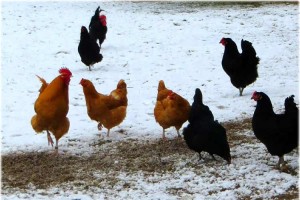Daylight hours and temperatures decrease throughout October, gradually turning fall to winter. My chickens have noticed the shorter days; they’re laying fewer eggs and opt to snooze on the roost over early morning free ranging.
6 step coop prep
- The main function of light in the coop is to facilitate sight and increase egg production. Layers require at least 14 hours of light per day for optimal production. Light can also provide supplemental heat.
- Pioneers raised chickens in the winter without heating the coop. Supplemental heat is unnecessary for hardy breed birds. That said, I provide supplemental heat when the temperature is below 0 degrees F to keep my girls comfortable. 250W infrared heat lamps over the roost also provide light.
Good insulation keeps the coop cozy and dry over winter.
- Prevent water troughs from freezing by placing heated bases underneath, or using electric waterers.
- Pests and rodents. Block low lying access points into the coop to prevent pests from taking up cool weather residence. Cover ventilation holes with fine wire mesh.
- Cleanliness and sanitation. Keeping the coop clean is the best way to prevent cool weather illnesses. Remove manure and soiled bedding and replace with dry bedding. Deliver fresh food and water daily.
Cool weather health concerns
Birds get colds and frostbite in cool weather just like humans. Chicks and pullets can be vaccinated against common poultry diseases.
The most common poultry health concerns in cool weather are: respiratory, cold/flu, frostbite and molting.
Watch for the following symptoms:
- Diarrhea
- Soft or misshapen eggshells, sudden stop in egg production
- Sneezing, coughing
- Nasal discharge
- Swelling around eyes and in neck
- Discoloration of wattles, combs and legs
- Muscle tremors
- Lethargy, not eating, drooping head and wings
Caring for sick chicks
Isolate sick bird(s) immediately in a warm and dry place to reduce chance of illness spreading to healthy birds, and to prevent healthy birds from picking on the infirm.
Add poultry electrolyte powder to water to help keep sick birds hydrated. Mix a bit of buttermilk in feed to treat diarrhea. Rest and relaxation are critical to regaining strength. Return birds to flock when they are healthy.
Frostbite is easily treated by cleaning the affected area and applying antibiotic ointment.
Molting is a natural part of bird life cycle in which birds lose feathers and stop laying eggs. I’ve noticed molting is most common in fall. Molting is completely natural. No treatment is necessary.







 Good insulation keeps the coop cozy and dry over winter.
Good insulation keeps the coop cozy and dry over winter.




